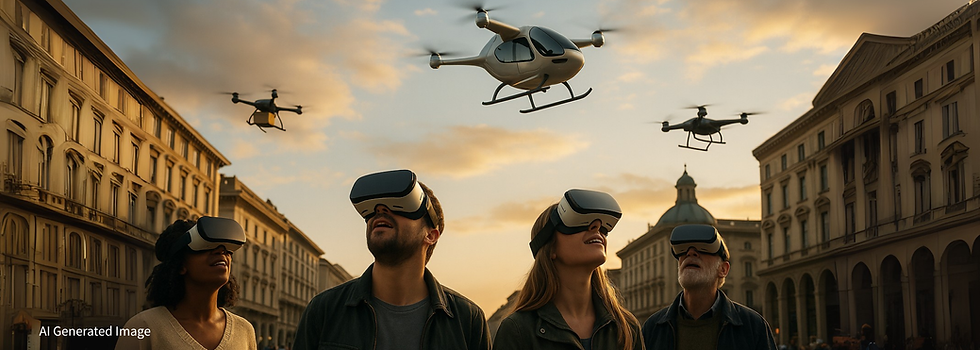Testing Tomorrow’s Skies Today: Exploring the Future of Air Mobility Through Virtual Reality
- ImAFUSA

- Jul 24
- 4 min read

What if you could stand in the middle of a city where the skies are alive with drones? Look up and see Unmanned Aerial Vehicles (UAVs) delivering parcels, checking air quality, or even flying people above the traffic?
Now imagine doing all that without even going outside. Welcome to a new kind of test flight, no boarding pass required.
At ImAFUSA, we are all about imagining and shaping the future of air travel, not just in the skies, but in the cities and communities we live in. One of the most powerful tools helping us do that is Virtual Reality.
Yes, you read that right. VR is not just for gaming or entertainment. It’s helping us explore how drones and other aerial vehicles could be part of our daily routines in ways that are safe, sustainable, and seamless.
So how does it work?
What if you could step into the future of air mobility?

Thanks to the cutting-edge VR environment developed by our project partner at Iscte - University Institute of Lisbon, we can do just that. This immersive platform allows us (and you) to explore what Innovative Air Mobility (IAM) might actually look and feel like in both urban and rural environments.
Imagine yourself in the middle of a busy city square or a quiet rural field, looking up as different types of drones pass by, some carrying parcels, others transporting people, and some quietly gathering important data to monitor air pollution or detect wildfires before they spread. This isn't science fiction, it's part of our research.
But why use VR for this?

VR isn’t just a fancy simulation. It’s a planning tool, and it’s helping us ask practical questions. Here is why it matters:
🔹 Simulating Real-Life Scenarios
With VR, we can model complex environments and test how different drone technologies behave in specific settings. This helps us make smarter, more responsive plans.
🔹 Designing Better Urban Integration
We are using VR to visualise where and how drones might operate in the future. Where should droneports be located? How visible, or discreet, should drones be in the sky? These are some of the practical challenges that need real answers.
🔹 Assessing Visual Pollution
Nobody wants a swarm of noisy drones ruining their view. That is why we use VR to assess something called visual pollution. In other words: with VR, we can test how different drone types, routes, and designs affect how people perceive their environment. Our goal is to design air mobility systems that work with, not against, the visual character of a place.
What do people think when they experience this in VR?
To get a real sense of public opinion, we invited participants from different countries to step into these virtual simulated environments and experience various drone types in action. Their reactions gave us valuable insights, but not only through what they said.
Using natural language processing (NLP) and machine learning models, our partners from Iscte - University Institute of Lisbon and ICCS-NTUA analysed participants’ feedback more deeply. This allowed us to go beyond surface-level impressions and uncover patterns in how people responded to different drone types in different settings.
Here is what we learned:
🔹 Cargo drones in rural areas didn’t go over well. Participants found them more disruptive in natural settings.
🔹 Urban drones were generally more accepted, likely because people are already used to visual and technological noise in cities.
🔹 Language matters. English-speaking participants showed higher levels of acceptance compared to Portuguese speakers, which suggests culture and language can shape the way new technologies are received.
Why does this matter for the future?

Because public acceptance is crucial to the success of IAM. If people are not on board, literally and figuratively, innovative air mobility will not take off.
That is why we are combining advanced technology like VR with tools like statistical modelling, natural language processing (NLP), and human-computer interaction (HCI) data. We want to understand not just what people think, but why, and how we can design systems they feel comfortable with.
What’s next?
We’re proud to share that these findings were presented at the HCI International 2025 Conference in Sweden. Our paper dives deeper into how immersive technology can support better planning, better design, and most importantly, better communication with future users.
Want to know more about how we're making air mobility human-centred? Keep following the ImAFUSA blog for updates from the skies and our labs where we’re helping shape the future.
For our researchers Sofia Samoili, Panagiotis-Eleftherios Eleftherakis, Margarida Lopes, Helena Filipe Almeida, James McLeod, George Anagnostopoulos, Konstantinos Iliakis, Sotirios Xydis and Sophia Kalakou), the sky is not the limit, only the starting point.
Follow our social media channels to stay informed with the latest news as we continue exploring innovative tools like VR to support smarter, safer, and more accepted air mobility systems.



